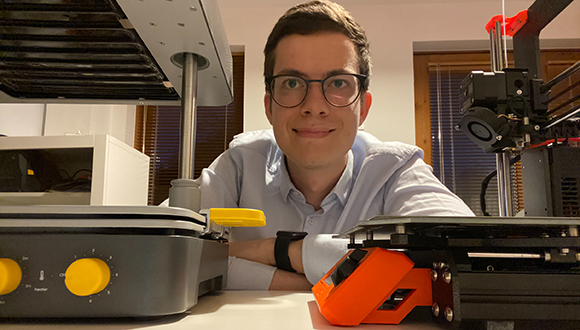Tue, 10 January, 2023
How a ship launching ceremony inspired Norbert to become a Mechanical Engineering
Norbert Sieczkiewicz's childhood involved a lot of IT. From playing with palmtops to flashing their firmware and even supporting open-source projects. However, it was the visits to his Father’s workplace in the shipbuilding industry, and watching the ship launching ceremonies in his hometown, witnessing everything in one place - the hidden mechanical and collaborative work of hundreds of engineers, technicians and fabricators involved in releasing one piece of design, and the scientific phenomena of a ship breaking water tension - that intrigued him to join the community of engineers.
Norbert completed his Bachelor's in Mechanical Engineering and Master of Engineering from the West Pomeranian University of Technology in Szczecin, Poland, where he received a Chancellor's Scholarships for both degrees and has written several research articles with Prof Jerzy Nowacki.
In 2019, he went on to expand his expertise in welding and completed an International Welding Engineer Diploma to become a certified International Welding Engineer (IWE), and has written chapters for training books on micro bonding and friction stir welding for the Portuguese Welding Institute, ISQ.
Later the same year, Norbert enrolled in the NSIRC PhD programme with a studentship awarded by Lancaster University and funded by Lloyd's Register Foundation (LRF).
Talking about his industry focused academia, Norbert said “I was extremely lucky that I was placed in the Electron Beam section at TWI Ltd, where I met a lot of skilled people and experts. The amount of support I received, from both Lancaster, TWI and LRF, helped me understand that collaboration between academia and industry plays a crucial role in developing solutions based on research and practical applicability.”
Approaches to Industry 4.0 Implementation for Electron Beam Quality Assurance using BeamAssure™
 Photo: Norbet Sieczkiewicz
Photo: Norbet Sieczkiewicz
Norbert designed a controlled experiment, focusing on the keyhole stability and gap defects.
During the experiment, titanium alloy (Ti-6Al-4V) samples were welded, with a gap opened stepwise to simulate gap defects and introduce keyhole instability.
Experiments were conducted to investigate monitoring of the keyhole stability with a high dynamic range camera and detection of back scattered electrons (BSE).
A comparison between longitudinal weld sections, BSE signals and processed camera images revealed a weld pool instability on every step of the gap.
Time-series data encoding method, including Recurrence Plots (RP), Gramian Angular Fields (GAF), and Markov Transition Fields (MTF), supported by deep learning, showed that it was possible to classify the stability of the keyhole, which can help to detect weld instability if it occurs.
A signal visualisation tool is presented, which can contribute to a better understanding of back scattered electron signal patterns, by using multisensor data fusion and time-series data encoding for a deep learning approach.
The results showed that the camera and BSE collector provided a promising approach for quality assurance in EBW and could lead to higher weld integrity and better process monitoring.
Research from this study will enable the application of the image classification model to beam probe data and discriminate between different beam current densities, as well as the beams and BeamAssure data.
At the same time, the research will help industries with the automatic detection of machine faults before welding or additive manufacturing is carried out. Additionally, the way the data is categorised can be adapted to the industrial requirements and is not limited to detecting focus states of the signal.
Academia with greater exposure to industry
During his enrolment at NSIRC, Norbert has presented his research at Industry 4.0 Summit held in Manchester; When CAE Simulation Meets Artificial Intelligence organised by the University of Warwick; the Virtual International Electron Beam Welding Conference held in Germany and the Virtual EBT Conference in Bulgaria.
His research has also been published at the 6th International Electron Beam Welding Conference.
In 2021 Norbert won the Runner-up award for the Third Academic Year Oral Presentation at the NSIRC Research and Innovation Conference. His presentation is available to watch on YouTube.
While looking back on his memories, Norbert said, “These small steps helped me build confidence and motivated me to continue on the engineering path. The recognition showed me that people appreciate my work and was a great motivation to further improve.”
Contributing to industries beyond engineering
After passing his doctoral defence, Norbert started working as a Science & Research Engineer, New Technology Research at Dyson and soon become a full-time member of the staff. Before this, he had worked as Project Support in Technology Innovation Management section at TWI.
Also, Norbert is one of the students who started working during COVID-19 and spent a significant time working on his research, learning and improving skills. During leisure time he works on his childhood passion for IT and built automatic audio source switching. For which he now holds a patent.
The contribution made by Norbert in interdisciplinary research is evidence of the quality of his research. Norbert is now planning to show the product based on his patent to the market and to continue enjoying his spare time with his partner, whom he met in Cambridge.